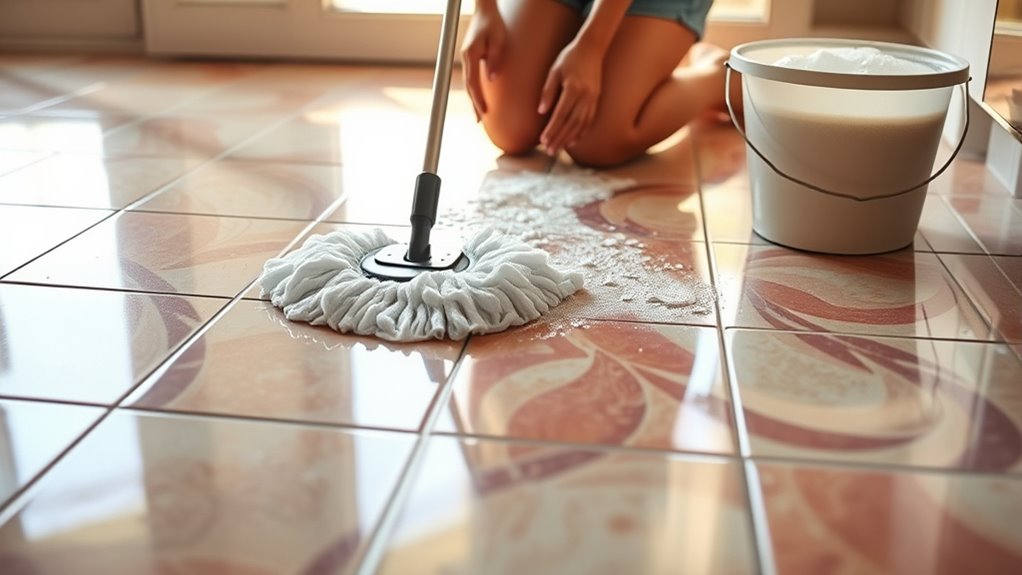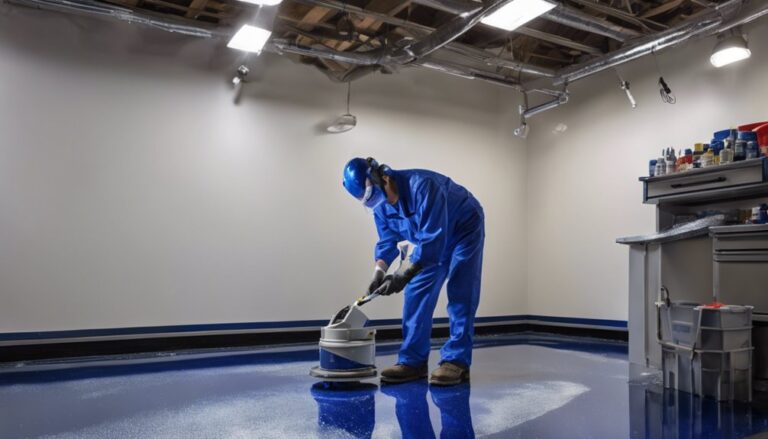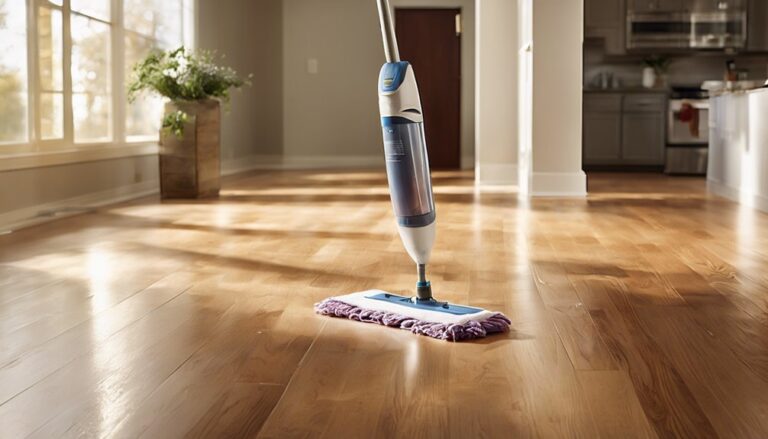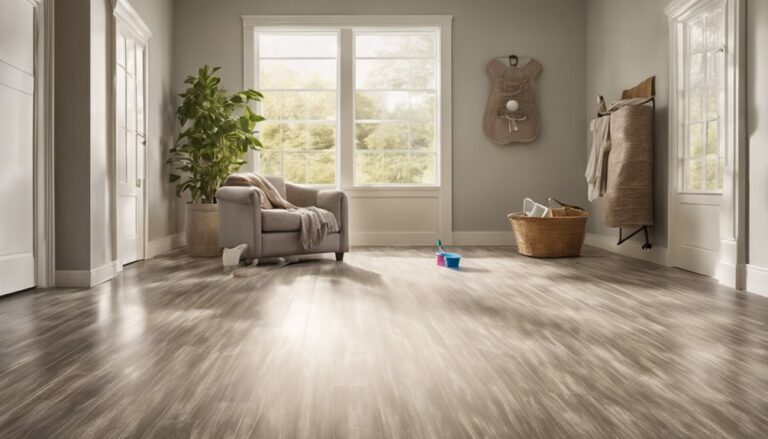To clean your ceramic tile floor effectively, start by sweeping or vacuuming to remove loose dirt. Use a pH-neutral cleaner and mop in straight lines, avoiding excess water that can damage grout. For tough stains, apply a gentle cleaner or a baking soda paste, scrubbing lightly with a soft brush. Dry thoroughly with a microfiber cloth to prevent water spots. Following these steps guarantees a clean, polished vloer, and understanding proper maintenance will help keep your tiles looking their best.
Understanding Ceramic Tile Characteristics

Ceramic tiles are durable, water-resistant surfaces composed primarily of clay and other natural materials, fired at high temperatures to achieve hardness. When you understand ceramic tile durability, you appreciate its resistance to scratches, stains, and moisture, making it ideal for floors. The tile surface texture plays an essential role in maintenance; smoother surfaces are easier to clean but can be slippery, while textured tiles offer better grip but may trap dirt more readily. Knowing these characteristics empowers you to choose appropriate cleaning methods that preserve the tile’s integrity. By respecting the tile surface texture and inherent durability, you gain freedom from frequent repairs or replacements, ensuring your ceramic floor remains both attractive and functional for years. This foundation is important before you proceed with cleaning steps.
Gathering Essential Cleaning Supplies
To clean your ceramic tile floor effectively, you’ll need a few basic tools like a broom, mop, bucket, and soft-bristle brush. Choosing the right cleaning solutions is vital—opt for pH-neutral cleaners designed specifically for ceramic tiles to avoid damage. Having these essentials ready guarantees you’ll maintain your floor’s appearance and longevity with every cleaning.
Basic Cleaning Tools
Although cleaning a tile floor might seem straightforward, having the right tools on hand is essential to achieve a thorough and efficient job. You need equipment that lets you tackle dirt without restricting your freedom to move or leaving residue behind.
Here are the basic cleaning tools you should gather:
- Cleaning brushes – Opt for various sizes to reach grout lines and corners effectively.
- Microfiber cloths – Perfect for wiping and drying surfaces without scratching.
- A sturdy mop – Choose one with an adjustable handle and a washable head.
- A bucket with a wringer – Helps control water usage and keeps your mop clean.
With these tools ready, you’ll maintain your ceramic tile floors efficiently, preserving their appearance and your independence in upkeep.
Recommended Cleaning Solutions
Since using the right cleaning solutions is essential for protecting your tile’s finish and grout integrity, you’ll want to select products that effectively remove dirt without causing damage. Start by considering eco friendly options; these are less harsh, biodegradable, and safer for your indoor air quality. Look for pH-neutral formulas designed specifically for ceramic tile to avoid etching or discoloration. Commercial cleaners can be effective but choose ones labeled safe for ceramic surfaces to prevent residue buildup. Avoid abrasive or acidic solutions that can degrade grout. You might also prepare a simple mixture of warm water and mild dish soap for routine cleaning. Always test any cleaner in a small, inconspicuous area first. By carefully choosing your cleaning solutions, you maintain your tile’s appearance and enjoy greater freedom with a safe, effective routine.
Preparing the Floor for Cleaning
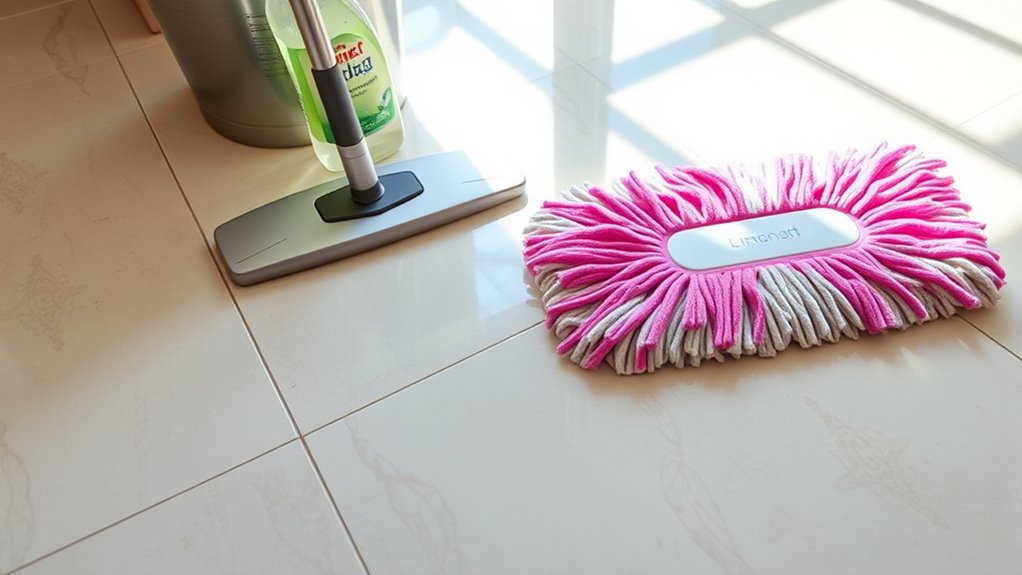
Before you start cleaning, make certain to clear the floor of any furniture or objects to access the entire surface. Next, sweep or vacuum thoroughly to remove dust, dirt, and loose debris that can scratch the tiles during washing. This preparation guarantees a more effective and safe cleaning process.
Clear the Surface
Start by removing all items from the tile floor, including rugs, furniture, and any loose debris. This step is crucial for effective surface preparation, allowing you unrestricted access to every inch of the tile. Proper clearing enhances cleaning efficiency and prevents damage to your belongings. To prepare your floor thoroughly:
- Move all movable furniture and decorative items out of the room.
- Pick up small objects or toys scattered on the floor.
- Roll up and remove any rugs or mats covering the tile.
- Dispose of loose debris such as dust, crumbs, or pet hair.
Adhering to this routine guarantees your cleaning frequency maintains the floor’s pristine condition and extends its lifespan. Clearing the surface thoroughly sets the stage for a deep, unrestricted clean.
Sweep or Vacuum
Regularly sweeping or vacuuming your ceramic tile floor is essential to remove dust, dirt, and debris that can scratch the surface during deeper cleaning. When sweeping, use a soft-bristle broom and employ controlled, short strokes to gather particles without pushing them into grout lines. Avoid harsh sweeping techniques that might scatter debris or damage tiles. For vacuuming, select a model with a hard floor setting or a brushless suction head to prevent scratching. Vacuum slowly and cover the entire floor systematically to guarantee no dust is left behind. Pay special attention to corners and edges where dirt tends to accumulate. Mastering these sweeping techniques and vacuuming tips will prepare your floor efficiently, preserving its finish while granting you the freedom to clean confidently and effectively.
Verwijder los vuil
Once you’ve swept or vacuumed the floor, the next step is to remove any remaining loose debris that might have settled or been missed. Different debris types—such as dust, pet hair, and small particles—can cling to grout lines or corners. Addressing these guarantees a thorough clean and maintains your tile’s appearance. Depending on cleaning frequency, this step might be quick or require more attention. Here’s how to remove loose debris effectively:
- Use a microfiber cloth or mop to capture fine dust.
- Employ a soft-bristle brush for grout lines.
- Check corners and under furniture for hidden particles.
- Dispose of collected debris promptly to prevent redistribution.
This meticulous approach assures a pristine surface, setting the stage for deeper cleaning and preserving your freedom from ongoing dirt buildup.
Sweeping and Vacuuming Loose Dirt
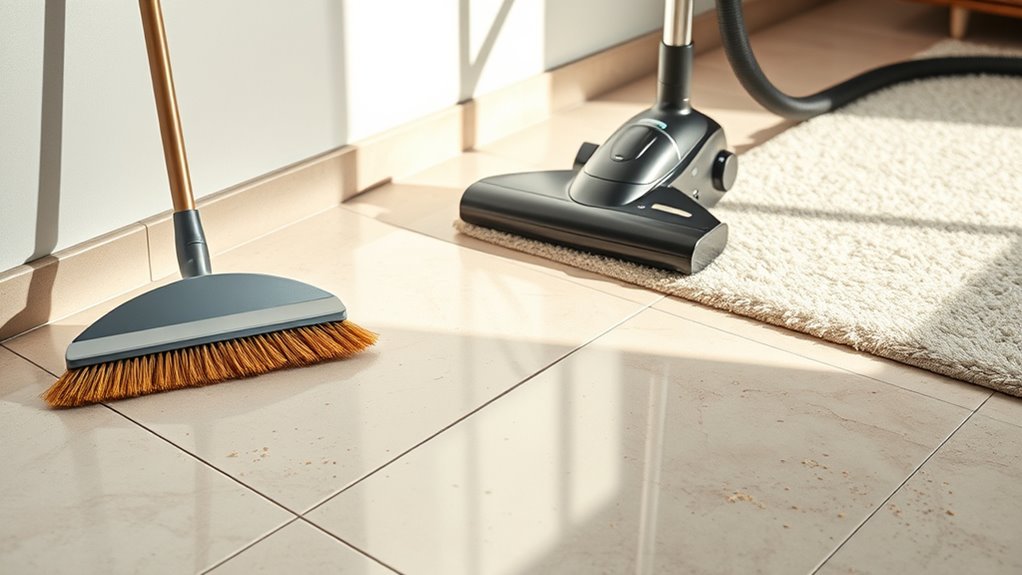
Before applying any wet cleaning methods, you’ll want to remove all loose dirt and debris from your ceramic tile floor. Sweeping and vacuuming are essential steps in effective dust control and overall floor maintenance. Use a soft-bristle broom to sweep thoroughly, paying special attention to corners and grout lines where dirt tends to accumulate. For a more efficient approach, vacuum with a hard floor setting or a vacuum designed for hard surfaces to avoid scratching the tiles. This removes finer particles that sweeping might miss, ensuring a cleaner surface. By consistently removing loose dirt, you prevent abrasive particles from damaging your floor’s finish and maintain its pristine appearance. Proper dust control through these methods sets a solid foundation for subsequent cleaning steps, promoting long-lasting floor freedom and cleanliness.
Choosing the Right Cleaning Solution
Although selecting a cleaning solution might seem straightforward, choosing the right one for your ceramic tile floor is essential to preserve its finish and prevent damage. You want a product that effectively cleans without compromising your tile’s integrity. Here’s what to take into account:
- Opt for eco friendly options to reduce chemical exposure and protect indoor air quality.
- Verify the cleaner has a neutral pH balance; acidic or alkaline solutions can dull or etch the tile surface.
- Avoid harsh abrasives or bleach-based products that may degrade grout or tile glaze.
- Choose a solution specifically formulated for ceramic tiles to guarantee compatibility and best results.
Mopping Techniques for Ceramic Tiles
Selecting the right cleaning solution sets the stage for effective mopping, which plays a key role in maintaining your ceramic tile’s appearance and longevity. When you begin, use a microfiber or sponge mop to avoid scratching the surface. Start mopping from one corner, moving systematically in straight lines to guarantee full coverage without missing spots. Avoid excessive water, as standing moisture can weaken grout and damage tile over time. Rinse your mop frequently to prevent redistributing dirt. After mopping, dry the floor with a clean cloth or allow it to air dry to prevent streaks. Mastering these mop techniques supports your tile maintenance routine, preserving both the tile’s finish and structural integrity, ultimately giving you the freedom to enjoy a pristine, durable floor.
Removing Stubborn Stains and Grime
When tough stains and grime resist regular cleaning, you’ll need targeted methods to restore your ceramic tile’s appearance. Effective stain removal and grout cleaning are vital to maintain your floor’s freedom from dirt buildup. Follow these steps:
- Apply a pH-neutral cleaner or a mixture of baking soda and water directly to the stain.
- Let it sit for 5-10 minutes to break down grime without damaging the tile.
- Use a soft-bristle brush, focusing on grout lines, to lift embedded dirt.
- Rinse thoroughly with clean water and dry the area to prevent residue buildup.
Consistent attention to stubborn stains and grout guarantees your ceramic tile floor remains pristine, preserving both beauty and durability.
Drying and Polishing the Tile Surface
A properly dried and polished ceramic tile surface not only enhances its appearance but also prevents water spots and streaks that can dull its finish. To dry your tiles effectively, use microfiber mops or absorbent towels, which quickly wick away moisture without leaving lint behind. Avoid air-drying, as it can cause uneven water marks. For polishing techniques, apply a small amount of a specialized tile polish or a mixture of water and vinegar with a soft cloth, buffing in circular motions to restore shine. Always test polishing solutions on a small area first to verify compatibility. By mastering these drying methods and polishing techniques, you’ll keep your ceramic tiles looking pristine, preserving both their beauty and durability without unnecessary effort or harsh chemicals.
Preventative Measures to Maintain Cleanliness
Maintaining the polished look of your ceramic tile floor requires more than just drying and buffing; it involves consistent preventative measures to keep dirt and grime at bay. Preventive maintenance is key to extending the life and appearance of your flooring. You should adopt these four essential practices:
- Conduct regular inspections to identify cracks, grout damage, or stains early.
- Use doormats to reduce dirt tracked inside, minimizing abrasive particles on tiles.
- Clean spills immediately to prevent staining and grout deterioration.
- Avoid harsh chemicals; opt for pH-neutral cleaners to protect glaze and grout integrity.

